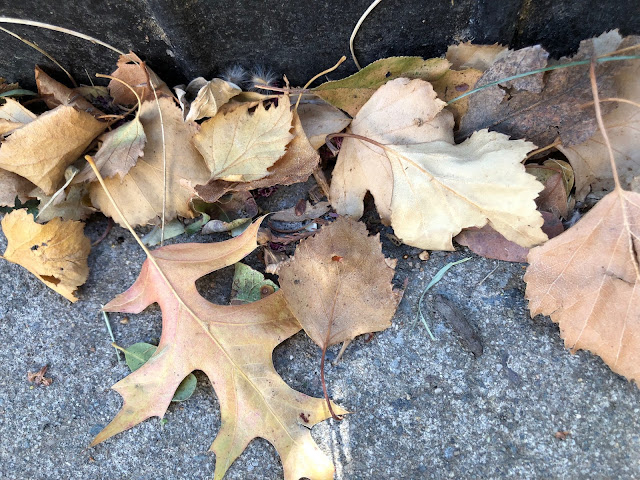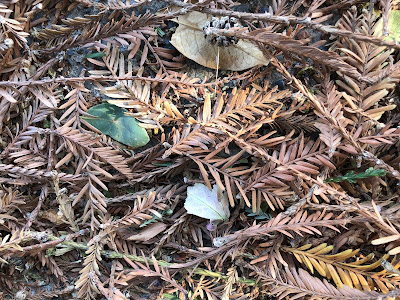
Brown foliage needed for compost, too

|
|
With extra help from the strong winds recently, leaves are starting to accumulate.
Use them for mulch or compost. (Photos: Kathy Morrison)
|
There’s a reason they call it “fall.”
Recent windy conditions brought down an avalanche of leaves in my yard – the first big dump of autumn. With every gust, more leaves rained down, coating the patio with a blanket of gold and brown.
I know I’m not the only one in the City of Trees with this annual dilemma: What to do with all those leaves?
Start by thinking like Mother Nature. It’s not a mess – it’s mulch!
Trees drop leaves, in part, to keep their roots cozy in winter. The fallen foliage also replenishes nutrients in the soil.
Dropped leaves on the patio aren’t doing my trees any good. But as mulch or compost, those cast-off leaves will benefit the trees and the rest of my garden, too.
Smaller leaves, such as birch, pistache or elm, make excellent mulch as is; just rake and place 2 to 3 inches deep around trees and shrubs.
Or chop larger leaves with a lawn mower (a couple of passes usually is sufficient) and use as mulch. It will last through the winter, keeping down weeds while retaining even soil moisture. Some waxy leaves, such as magnolia, may take several seasons to break down.
One note on turning fall foliage into mulch: Don’t use any diseased leaves. If the foliage is showing signs of mildew or other fungal disease or pests, discard it in the trash – not the green waste or your garden. Otherwise, you’re recycling problems along with the leaves.

|
|
Fallen redwood needles can be used as mulch for azaleas
or camellias.
|
Although they’re evergreens, coastal redwoods are susceptible to drought. Those browned needles are signs of stress. Consider having an arborist check the tree’s health.
Meanwhile, those browned needles make durable mulch, especially for acid-loving shrubs such as azaleas or camellias.
Add fall leaves to your compost pile, too. Plus save some for later.
Dried leaves are a necessary ingredient in compost. To promote rapid breakdown in compost, an even amount of “browns” (dried leaves, straw or other dry ingredients) are mixed with “greens,” such as freshly cut grass, spent vegetable plants or kitchen waste.
While dried leaves are plentiful now, come spring they’ll be in short supply. So, bag up some brown leaves to add to your compost pile in March or April to keep it “cooking.”
Comments
0 comments have been posted.Sacramento Digs Gardening to your inbox.
Sites We Like
Garden Checklist for week of May 5
Survey your garden after the May 4 rainstorm. Heavy rain and gusty winds can break the neck of large flowers such as roses. Also:
* Keep an eye on new transplants or seedlings; they could take a pounding from the rain.
* Watch out for powdery mildew. Warmth following moist conditions can cause this fungal disease to “bloom,” too. If you see a leaf that looks like it’s dusted with powdered sugar, snip it off.
* After the storm, start setting out tomato transplants, but wait on the peppers and eggplants (they want warmer nights). Pinch off any flowers on new transplants to make them concentrate on establishing roots instead of setting premature fruit.
* Trim dead flowers but not leaves from spring-flowering bulbs such as daffodils and tulips. Those leaves gather energy to create next year's flowers. Also, give the bulbs a fertilizer boost after bloom.
* Pinch chrysanthemums back to 12 inches for fall flowers. Cut old stems to the ground.
* Mulch around plants to conserve moisture and control weeds.
* From seed, plant beans, beets, cantaloupes, carrots, corn, cucumbers, melons, pumpkins, radishes and squash.
* Plant onion sets.
* In the flower garden, plant seeds for asters, cosmos, celosia, marigolds, salvia, sunflowers and zinnias. Transplant petunias, zinnias, geraniums and other summer bloomers.
* Plant perennials and dahlia tubers for summer bloom.
* Don’t wait; plant summer bulbs, such as gladiolus and tuberous begonias.
* Harvest cabbage, lettuce, peas and green onions.